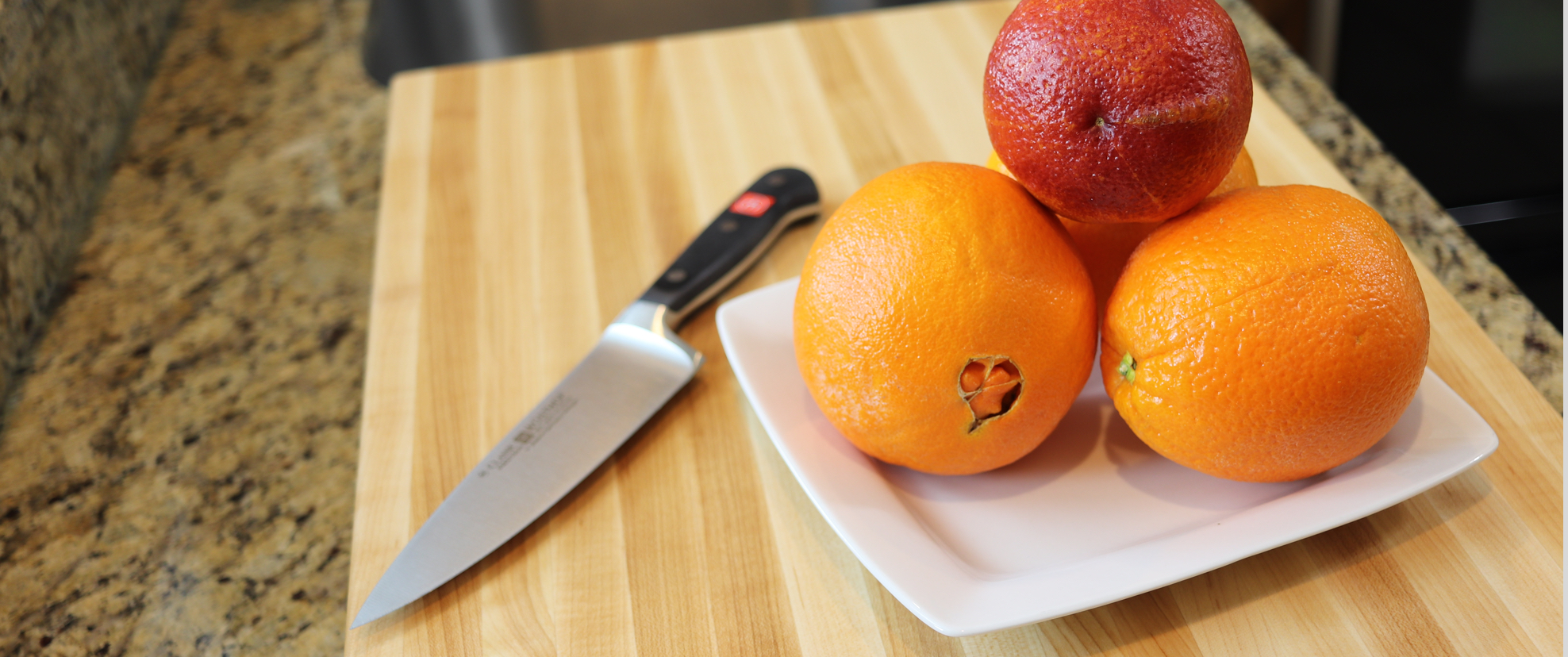
How to Cut an Orange
IF ZESTING, ZEST FIRST
Before we get into cutting the orange, let’s talk about zesting. You want to zest your orange or whatever citrus fruit you have BEFORE you cut it, obviously it’s easier to hold the entire fruit and instead of just one little slice.
First, wash your fruit really well under running water, dry it off with a paper or kitchen towel, you don’t often think of washing citrus if your peeling it or juicing it. Now we are going to be using a microplane zester. It has these very very little, micro, cutting blades, that shave off a tiny amount of the the zest or rind of the fruit. A microplane is also fantastic for finely grating fresh nutmeg, hard cheeses like parmesan and even chocolate. You definitely want to get one of these for your kitchen.
You want to make sure you stay just to the farthest outside layer, do not go in too far toward the white pithe, this will make your zest bitter. The flavor comes from the citrus oil locked in the skin and it will permeate into any dish you add it to. Use it like salt, a little goes a long way.
After you zest your orange, you can then juice it or cut it like we are going to do today.
WHAT IS SEGMENTING
First, I am going to show you how to segment an orange. Segmenting, which is also called supreme (I have no idea why), is removing just the inner-most flesh of the fruit to give you beautiful little juicy slices. It’s not the easiest method to master, so why go through the extra trouble? The pith of the fruit can be pretty bitter so removing all of its white parts guarantee sweetness without that bitter taste.
SECURE A BASE
So first, cut the top and bottom of the orange so the orange will sit flat on the cutting board. I’m using a 6 inch Wustoff chef's knife, but another great knife for this would also be a thin utility knife. Make sure to cut a big enough piece to see the flesh all the way down.
REMOVE OUTER SKIN
Cutting from the top to bottom, remove the peel and the pith, deep enough to remove the membrane and just leave the flesh of the orange. Go all the way around, and clean up any remaining membrane or pith.
CUT INDIVIDUAL SEGMENTS
Holding the orange in your hand, you might want to switch to a smaller paring knife for this more delicate work, and carefully cut between a segment and the membrane. Do NOT cut all the way through, just to the center. Once you hit the other side of the membrane, slide the knife up to peel off the segment.
This technique can be used with any type of citrus. I like to do this with grapefruit and sprinkle the segments with sugar or salt, really salt will take away the bitterness of the grapefruit, leaving you with a really sweet crisp finish.
WHAT TO LOOK FOR
You want to look for oranges that are firm and heavy for their size. Pass on oranges that have blemishes and soft spots, and avoid oranges that look dry. I have found that the best oranges have a thinner smoother skin, where the pithe is less developed. Oranges are in season in North America in the cold winter months, although you can find them year round, they are the sweetest and juiciest in the winter.
TYPES OF ORANGES
The first orange we have here is a Valencia. They have thin skins, some seeds, and are very juicy. They are the classic orange juice oranges, but are also perfectly delicious to just eat.
A Navel orange is the most common eating variety of orange. They are sweet, seedless, and classic orange-sized perfect for eating, they have medium to thick skins and a dimple on the not-stem end, thus the name. Navel oranges are juicy enough to juice, if you like, the juice is sweet, but it ferments easily, so use any juice right away.
A newer orange, to me at least, is Cara Cara. A wonderfully sweet navel orange from California. They have bright orange skins and pink fruit, so pretty. They have low acid and a great zingy bite behind their sweetness and tend to have very few, if any, seeds.
The last orange we are going to talk about is a Blood orange. They get their name from their deep red flesh. They're a smaller orange, quite sweet, and best used as fruit (rather than juice).
HOW TO STORE
You can store them in the fridge or at room temperature, I like my oranges ice cold, so I store mine in the crisper.
Go ahead and give segmenting a try, I am sure you will not be disappointed
